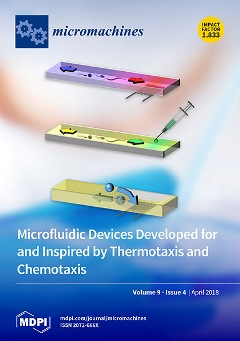Open AccessArticle
Progress on the Use of Commercial Digital Optical Disc Units for Low-Power Laser Micromachining in Biomedical Applications
by
Aarón Cruz-Ramírez, Raúl Sánchez-Olvera, Diego Zamarrón-Hernández, Mathieu Hautefeuille, Lucia Cabriales, Edgar Jiménez-Díaz, Beatriz Díaz-Bello, Jehú López-Aparicio, Daniel Pérez-Calixto, Mariel Cano-Jorge and Genaro Vázquez-Victorio
Cited by 7 | Viewed by 6229
Abstract
The development of organ-on-chip and biological scaffolds is currently requiring simpler methods for microstructure biocompatible materials in three dimensions, to fabricate structural and functional elements in biomaterials, or modify the physicochemical properties of desired substrates. Aiming at addressing this need, a low-power CD-DVD-Blu-ray
[...] Read more.
The development of organ-on-chip and biological scaffolds is currently requiring simpler methods for microstructure biocompatible materials in three dimensions, to fabricate structural and functional elements in biomaterials, or modify the physicochemical properties of desired substrates. Aiming at addressing this need, a low-power CD-DVD-Blu-ray laser pickup head was mounted on a programmable three-axis micro-displacement system in order to modify the surface of polymeric materials in a local fashion. Thanks to a specially-designed method using a strongly absorbing additive coating the materials of interest, it has been possible to establish and precisely control processes useful in microtechnology for biomedical applications. The system was upgraded with Blu-ray laser for additive manufacturing and ablation on a single platform. In this work, we present the application of these fabrication techniques to the development of biomimetic cellular culture platforms thanks to the simple integration of several features typically achieved with traditional, less cost-effective microtechnology methods in one step or through replica-molding. Our straightforward approach indeed enables great control of local laser microablation or polymerization for true on-demand biomimetic micropatterned designs in transparent polymers and hydrogels and is allowing integration of microfluidics, microelectronics, surface microstructuring, and transfer of superficial protein micropatterns on a variety of biocompatible materials.
Full article
►▼
Show Figures






